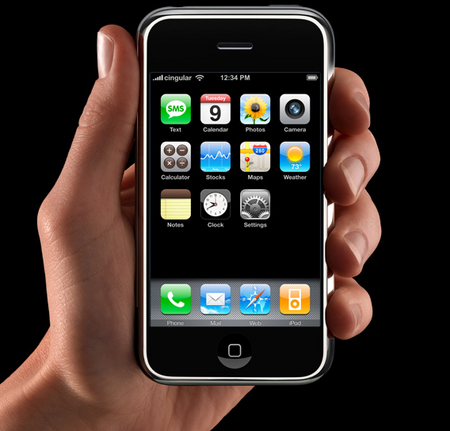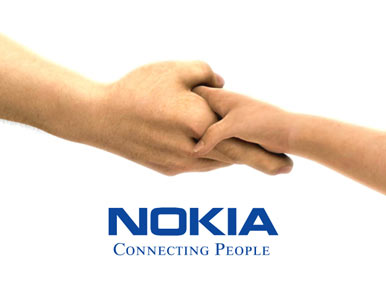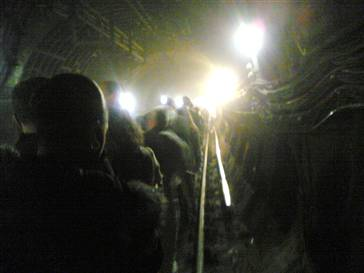The Limits of the Cellular Imaginary: iPhone and the Snuff Film
by: Eric Freedman / Florida Atlantic University

On December 30, 2006, Saddam Hussein was executed in Iraq, after being sentenced to death by hanging for crimes against humanity. Just over one week later, on January 9, 2007, Steve Jobs was played on stage to the tune of James Brown's “I Feel Good,” and proceeded to unveil the iPhone as part of his keynote address at Macworld in San Francisco. Though both men were on public display for quite different purposes, and on quite different stages, they were inevitably bound together by certain cultural logics of new media.
On my most recent visit to Google Video, a 2:36 minute clip of Saddam Hussein's execution had been viewed 15,605,630 times and had received a rating of 4 out of 5 stars (ranking it “above average”). But this clip is just one of many catalogued by Google Video, each of which has a unique title. While most of the entries feature the same video, recorded by a witness to the execution using a cell phone, others take some liberties with the footage, including a 4 minute piece titled “Swinging Saddam Execution Video,” described as a “groovy” video “starring GeGe the Go Go girl and her new dance the 'Saddam Swing'!” Another, titled “Hanging Saddam” features a 1:38 minute still image montage, a chronology framed by traditional wipe, dissolve, and Ken Burns effects, shaped into essayistic form by intertitles, and underscored by Green Day's “Good Riddance (Time of Your Life).”
Apple's inroads into the telecommunications business with its latest device, which Jobs proudly points out is not just a mobile phone, but also a widescreen iPod and an Internet communicator, is certainly part of a larger industrial history of cellular technology, and like the developments that precede it, the result of a persistent engagement with an evolving and inherently ideologically-charged visual interface. The architecture of the mobile phone platform is, after all, a language, and the latest revolution in user interfaces marks the degree to which hardware and software are conceptualized in tandem. In his discussion of cultural transcoding, Lev Manovich suggests that the computer layer and the cultural layer push against and shape each other, to the extent that the general computerization of culture in the digital age gradually substitutes existing cultural categories and concepts with new ones that derive from the computer's ontology.[i] A recent Apple press release suggests that the iPhone “completely redefines what you can do on a mobile phone,” suggesting that Apple has thought through what consumers should do with their mobile phones and has a few ideas about what consumers will actually do with their mobile phones, but according to an on-demand delivery logic of production, purposefully leaves open other possibilities.
This latest push in the pursuit of a digital lifestyle (also evidenced in Apple's introduction of the iLife suite in 2003, which integrated its previously distinct photo, video, and audio components, allowing them to operate within each other, and merged the “i” signifier with life itself) leads me to certain questions about the relationship between two forms of integration–one accomplished and evidenced by technological convergence and the other associated with the domain of trauma therapy. The former is of a physical and mechanical nature and the latter is psychical and biological. What connects these two enterprises (of integration) is the common push toward embodiment, as well as their mutual dependence on media.

Trauma theory positions those memories associated with traumatic experience in relation to dream logic, recorded not in a linear manner assigned to verbal narrative but in a manner that exceeds words and is fundamentally comprised of vivid sensations and images. The goal of trauma therapy is integrative, to move the victim through stages of safety, mourning, and ultimately reconnection to everyday life.[ii] This developmental trajectory aims to localize sensation, delimiting what was once excessive, and to reattach the subject.
Likewise, the push toward a singular (and coincidentally, Cingular) manifestation of the digital lifestyle is also about localizing sensation, investing in one device and channeling distinct media along one conduit. As Jobs suggests, the interface itself is fluid and responsive, its malleability an assurance that the iPhone can adapt to changes in the media landscape and retain its centrality. The “buttons” themselves are virtual and can be remapped; the hardware of the iPhone is almost as fluid as the software.
The general trend toward seamless mobility heralded in the research and development of new technologies (the integration of multiple feature-rich media devices and operating platforms–in the home, in the car, and at the office) is part of a larger projection of the future of liquid media (taking media and shaping it to the various circumstances that people find themselves in) that also wants to embroil the subject in the technology. New media industries are drafting biographical practices that can be subsequently attached to individual authors. The aim is to create new media frameworks that replicate subjectivity and merge the lived context with the apparatus of production, fostering the development of “technobiographies” that write the self through the post-industrial logic of new media. Responsive technologies seem to situate end-users as unique social actors, as inscribed data (though not governing code) accumulates and becomes symptomatic of our presence. New technologies may seem to operate freely, to the extent that they act intuitively, but their intuition is by design; it is inherently the result of a script (of a coding activity brought to fruition by developers). As we become conscious of the possibilities for remapping technology, do we overlook the limits of our own subjectivity, itself the product of an unseen script?

Motorola, in its “motocouture” ad campaign suggests its phones are “designed for desire.” As it gives form to the buzzwords of liquid media, the company purposefully speaks in between the polarities of the inorganic and the organic. Likewise, Nokia, in the business of “connecting people” positions its phones as a bridge between “vision” and “reality,” prompting users to re-imagine their worlds–a cultural re-imagining made possible only through technology. Yet in the same moment, the world is being more forcefully re-imagined and pointedly re-imaged; the relationship between vision and reality is not simply allegorical.
An August 2006 CNN.com article on the Israel-Lebanon conflict featured an image, recorded on a cell phone, of a building struck by a Hezbollah rocket. And one year earlier, the Washington Post ran an article featuring cell-phone images shot by people in the aftermath of the London terrorist attacks, highlighting pictures of transit passengers caught in a tunnel near King's Cross Station. Framed by the popular news media as a form of citizen journalism, from a more immediate vantage point, these sites of imaging, shared both locally and across the blogosphere, create a fabric of intimate communication, allowing photographer and viewer to shape the lexicon of terror.

If the cellular imaginary is in part the product of venture capital, what are the stakes for any photographic act that is not simply a recording, but potentially a working through? Or is working through even possible when diachronic continuity meets an assumed zenith in seamless mobility? Is post-traumatic integration even conceivable when images of terror never serve as meditative points divorced from an original act, never function as screen memories but instead as visible, contemporaneous evidence? As the temporal gap between production and distribution is closed, so too is the lag between occurring and witnessing. The role of memory is becoming more tenuous.
Yet far from simply communicating, sending images across the Internet, the cell phone user at ground zero is both witnessing and translating trauma. Though trauma, in critical discourse, has been inherently linked to modernity and its dissociating effects, we must reconsider the role of the citizen journalist who is creating cultural memories within the framework of being a traumatized subject, forever closing off the possibility of secondary revision. I am not suggesting that an execution and a bombing are parallel traumatic events; for an execution itself is not necessarily a site of public trauma, and the clandestine recording of an execution is not necessarily a journalistic act (though the act has subsequently become part of journalistic discourse). Yet once imaged, the artifact, the record itself may become its own site of trauma–this seems to be decidedly the case with the execution, where the act of producing and distributing (of recording and circulating) has created its own cultural rift. And as phones become rich HTML web browsers, no longer are images simply circulated as free-floating artifacts, but rather they are positioned alongside parallel or divergent discursive threads that exist simultaneously on Google Video or other database interfaces. In these frameworks, meaning is anchored by a series of preordained social bookmarks that seem to alter the type of working through that is possible. Saddam Hussein and the Go Go Girl are bound together, and an execution is situated concentrically with the iTunes store. While convergence has been positioned as liberating, integration may randomly generate cultural discord.
Notes
[i] Lev Manovich, The Language of New Media (Cambridge: The MIT Press, 2001), 46.
[ii] Judith Herman, Trauma and Recovery (New York: Basic Books, 1992), 155-156.
Image Credits:
1. iPhone
2. Nokia ad
3. Motorola
4. King’s Cross Station tunnel
Please feel free to comment.
Studies in new media
Great article. Informative and very true! Enjoyed reading it.
Trauma ad infinitum
Freedman considers well the potential effects of technological convergence on the condition of transnationally mobile trauma. I can’t help but wonder how these mediating devices are really changing those users who live the life technobiographic? Rather than saying “The role of memory is becoming more tenuous,” I might suggest that the role of memory becomes inescapable. For if much trauma therapy has moved away from active narration of the scenario to addressing the more immediately somatic manifestations of post-traumatic conditions, doesn’t the seemingly ubiquitous presence of these digitized reminders make the triggering of memory more or less inescapable? Where can the traumatized subject find any distance in this context?
Trauma?
As far as it taking away from the trauma theory I actually think it helps in getting over a big thing or tragedy. It helps the mind really understand what happened and creates a visual. I am not haunted by the images that I have seen nor do I go out looking for them but I do feel that is has helped me. But I do thing the digital culture does in fact directly relate to this outburst of media. It wouldn’t happen if there weren’t camera phones and youtube.com.
Pingback: Liquid media - so good it melts in your mouth at Mediacology